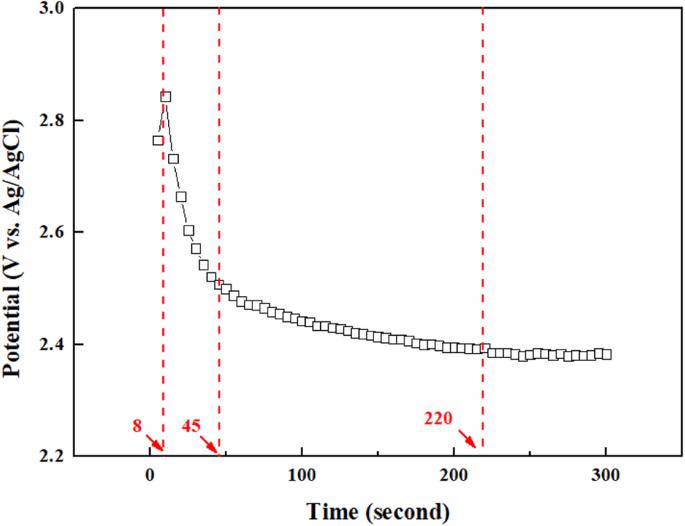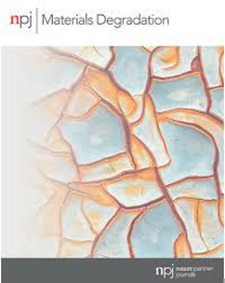等离子离子氮化和电抛光 UNS N08367 洗涤器洗涤水中的电化学特性和损伤机理
IF 7.6
2区 材料科学
Q1 MATERIALS SCIENCE, MULTIDISCIPLINARY
引用次数: 0
摘要
在这项研究中,对超级奥氏体不锈钢进行了电解抛光和等离子离子氮化处理,以提高其耐腐蚀性和抗点蚀性。电化学实验使用的是直接从船舶洗涤器中收集的洗涤水。与机械抛光相比,电抛光后的表面粗糙度提高了约 73.6%。等离子体离子氮化后,表面出现了 CrN(沉淀)、Fe4N(化合物)和 γN(固溶体)。经测量,表面形成的层厚度约为 10 μm。在机械抛光和电抛光的循环电位极化曲线中观察到一个滞后环,计算出的面积分别为 23.33 mW cm-2 和 0.17 mW cm-2。等离子体离子氮化的极化曲线呈现出完美的钝化特性。因此,机械抛光和电抛光显示的是局部腐蚀,而等离子体离子氮化显示的是整体腐蚀。在机械抛光、电抛光和等离子体离子氮化中,腐蚀电流密度分别为 0.665 μA cm-2、0.093 μA cm-2 和 16.47 μA cm-2。本文章由计算机程序翻译,如有差异,请以英文原文为准。

Electrochemical characteristics and damage mechanism in scrubber washing water of UNS N08367 with plasma ion nitriding and electropolishing
In this investigation, electropolishing and plasma ion nitriding are applied to super austenitic stainless steel for the purpose of improving its corrosion and pitting resistance. Electrochemical experiments are conducted with washing water collected directly from the ship’s scrubber. After electropolishing, the surface roughness is improved by about 73.6% compared to mechanical polishing. After plasma ion nitriding, CrN (precipitate), Fe4N (compound), and γN (solid solution) are observed on the surface. The thickness of the layer formed on the surface is measured to be about 10 μm. A hysteresis loop is observed in the cyclic potentiodynamic polarization curves of mechanical polishing and electropolishing, and the areas are calculated as 23.33 mW cm−2 and 0.17 mW cm−2, respectively. The polarization curve of plasma ion nitriding presents perfect passivation characteristics. Accordingly, mechanical polishing and electropolishing reveal local corrosion, whereas plasma ion nitriding presents a tendency towards general corrosion. In the mechanical polishing, electropolishing, and plasma ion nitriding, the corrosion current densities are 0.665 μA cm−2, 0.093 μA cm−2, and 16.47 μA cm−2, respectively, and the maximum damage depth is observed to grow progressively smaller from plasma ion nitriding to electropolishing and then mechanical polishing.
求助全文
通过发布文献求助,成功后即可免费获取论文全文。
去求助
来源期刊

npj Materials Degradation
MATERIALS SCIENCE, MULTIDISCIPLINARY-
CiteScore
7.80
自引率
7.80%
发文量
86
审稿时长
6 weeks
期刊介绍:
npj Materials Degradation considers basic and applied research that explores all aspects of the degradation of metallic and non-metallic materials. The journal broadly defines ‘materials degradation’ as a reduction in the ability of a material to perform its task in-service as a result of environmental exposure.
The journal covers a broad range of topics including but not limited to:
-Degradation of metals, glasses, minerals, polymers, ceramics, cements and composites in natural and engineered environments, as a result of various stimuli
-Computational and experimental studies of degradation mechanisms and kinetics
-Characterization of degradation by traditional and emerging techniques
-New approaches and technologies for enhancing resistance to degradation
-Inspection and monitoring techniques for materials in-service, such as sensing technologies
 求助内容:
求助内容: 应助结果提醒方式:
应助结果提醒方式:


